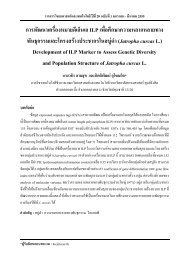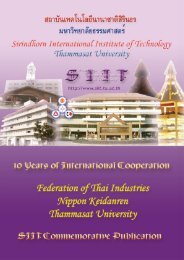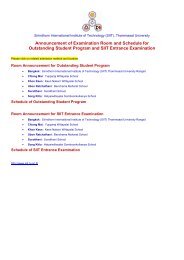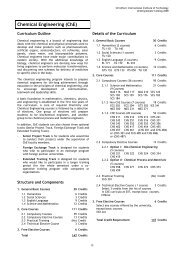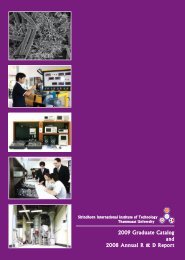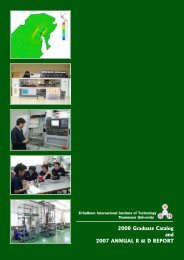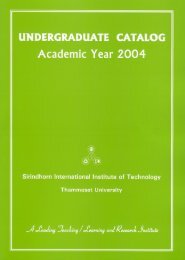2007 Graduate Catalog and 2006 Annual R & D Report - Sirindhorn ...
2007 Graduate Catalog and 2006 Annual R & D Report - Sirindhorn ...
2007 Graduate Catalog and 2006 Annual R & D Report - Sirindhorn ...
Create successful ePaper yourself
Turn your PDF publications into a flip-book with our unique Google optimized e-Paper software.
<strong>2007</strong> <strong>Graduate</strong> <strong>Catalog</strong> <strong>and</strong> <strong>2006</strong> <strong>Annual</strong> R & D <strong>Report</strong><br />
<strong>Sirindhorn</strong> International Institute of Technology (SIIT)<br />
School of Bio-Chemical Engineering <strong>and</strong> Technology<br />
Faculty Members <strong>and</strong> Research Interests, <strong>2007</strong><br />
Dr. Luckhana Lawtrakul<br />
Assistant Professor<br />
B.Sc. in Chemistry, Kasetsart University, Thail<strong>and</strong><br />
M.Sc. in Physical Chemistry, Kasetsart University, Thail<strong>and</strong><br />
Dr.rer.nat. in Theoretical Biochemistry, University of Vienna, Austria<br />
Areas of Specialization: Computational Chemistry, Computer-Aided Molecular Modeling <strong>and</strong> Molecular<br />
Design, Structure-Activity Relationships.<br />
Research Interest:<br />
Molecular modeling is a collective term that refers to<br />
theoretical methods <strong>and</strong> computational techniques to<br />
model or mimic the behavior of molecules. The<br />
techniques are used in the fields of computational<br />
chemistry <strong>and</strong> computational biology for studying<br />
molecular systems ranging from small chemical<br />
systems to large biological molecules. Currently<br />
applications in the following areas are of special<br />
concern: Molecular dynamics (MD) simulations <strong>and</strong><br />
quantum chemical calculations on the stability of<br />
guest-cyclodextrins inclusion complexes, <strong>and</strong><br />
Quantitative structure-activity relationship (QSAR)<br />
studies of inclusion complexes of various guests with<br />
cyclodextrins.<br />
Dr. Pisanu Toochinda<br />
Lecturer<br />
B.Sc. in Chemistry, Mahidol University, Bangkok, Thail<strong>and</strong><br />
M.Sc. in Chemical Engineering, The University of Akron, Akron, Ohio, USA<br />
Ph.D. in Chemical Engineering, The University of Akron, Akron, Ohio, USA<br />
Areas of Specialization: Photo-catalytic synthesis of hydrocarbons from CO 2 /H 2 O, Photochemical solar cells,<br />
Gas-solid reactor design, Heterogeneous catalysis, Nano-material / zeolite syntheses, Bio-molecular imprinted<br />
materials.<br />
Research Interests:<br />
Carbamate <strong>and</strong> Isocyanate Synthesis from Gas-<br />
Solid Catalytic Oxidative Carbonylation Reactions<br />
Development of environmentally benign synthesis<br />
processes that eliminate toxic feedstocks, combine<br />
process steps, <strong>and</strong> result in a net reduction of<br />
pollutants <strong>and</strong> energy use rests on, to a great extent,<br />
innovations in reactor design, reaction pathways, <strong>and</strong><br />
catalysis.<br />
Carbonylation reactions serve as a new route for nonphosgene<br />
processes in the production of carbamates<br />
<strong>and</strong> isocyanates at mild conditions for the<br />
replacement of highly toxic phosgene in the synthesis<br />
of carbamates <strong>and</strong> isocyanates. Combining the gassolid<br />
reactor system <strong>and</strong> the Pd-based catalysts could<br />
provide promising alternatives for carbamate <strong>and</strong><br />
isocyanate synthesis in the industry.<br />
Photocatalysis<br />
CO 2 emission has become a worldwide problem due<br />
to its potential impact on global warming.<br />
Photocatalytic reactions, which involve the combined<br />
use of photo energy <strong>and</strong> catalysts to convert<br />
reactants to products, provide a promising alternative<br />
to reduce CO 2 <strong>and</strong> convert it into useful hydrocarbon<br />
products (e.g., methane <strong>and</strong> methanol).<br />
Photochemical Solar Cells<br />
Solar energy could be converted into electrical energy<br />
via photochemical solar cells. A promising type of<br />
solar cell is based on commercially feasible <strong>and</strong><br />
chemically stable wide-b<strong>and</strong>gap semiconductors (ie.<br />
TiO 2 ). In order to enhance the sensitivity of the cell to<br />
solar radiation, sensitizing organic dyes or<br />
semiconductor nanocrystals are coated on the metal<br />
oxide surface. While the solar cell is exposed to the<br />
sun, the sensitizers donate electrons into the oxide<br />
conduction b<strong>and</strong>, after which harvesting of the<br />
electrons takes place, leading to solar power<br />
generation.<br />
13




